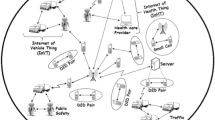Abstract
5G wireless networks envision the usage of millimeter Wave (mmWave) frequencies for a manifold data rates and user capacity increase. However, the inherent line-of-sight (LoS) in mmWave communications raises significant challenges in providing seamless coverage across the dense 5G networks. Device-to-device (D2D) communications offer promising solutions for this LoS challenge by providing relay services. The selection of relay requires maintaining a certain level of trust and confidentiality of the devices. In this paper, we utilize social relationships among devices to form personal trust among different devices. Subsequently, we introduce distributed architecture for social relationships in D2D communications and we discuss new methods for a dynamic social relationship and trust management paradigm. Our analytical models not only show that the proposed scheme achieves 10% - 80% gain in device capacity, 30% - 200% increase in data rates, with approximately 50% less energy consumption over earlier methods, but also discuss co-existence with existing SINR based relay selection schemes. We present temporal dynamics of our social-communication graph using the random graph and Markov process. Our NS3 based 5G simulations demonstrate that our scheme obtains 3 - 5 times more throughput and 50 - 100m coverage extension, with relatively negligible additional delay.










Similar content being viewed by others
Notes
CISCO, VNI 2016-2021 [Date Accessed: 13-June-2019] www.cisco.com/c/en/us/solutions/collateral/service-provider/visual-networking-index-vni/mobile-white-paper-c11-520862.html
Global internet usage statistics (Statista, www.statista.com [Date Accessed: 13-June-2019])
NS3 mmWave Module for 5G network [Date Accessed: 13-June-2019] https://github.com/nyuwireless/ns3-mmwave
References
Agiwal M, Roy A, Saxena N (2016) Next generation 5G wireless networks: a comprehensive survey. IEEE Communications Surveys and Tuts 18(3):1617–1655
Rangan S, Rappaport TS, Erkip E (2014) Millimeter-wave Cellular Wireless networks: Potentials and Challenges. Proceedings of the IEEE 102(3):366–385
Cacciapuoti AS (2017) Mobility-aware User Association for 5G mmWave Networks. IEEE Access 5:21497–21507
Caleffi M, Trianni V, Cacciapuoti AS (2018) Self-organizing Strategy Design for Heterogeneous Coexistence in the Sub-6 GHz. IEEE Transaction on Wireless Communications 17(11):7128–7143
Kumbhar FH, Saxena N (2017) A Roy Reliable relay: Autonomous Social D2D Paradigm for 5G LoS Communications. IEEE Communications Letters 21(7):1593–1596
Li Yong, Shuang S u, Chen Sheng (2015) Social-aware Resource Allocation for Device-to-Device Communications Underlaying Cellular Networks. IEEE Wireless Communications Letters 4(3):293–296
Zhao Y, Yong Li Y, Cao Y, Jiang T, Ning G (2015) Social-Aware Resource Allocation for Device-to-Device Communications Underlaying Cellular Networks. IEEE Transaction on Wireless Communications 14(12):6621–6633
Datsika Eftychia, Antonopoulos Angelos, Zorba Nizar, Verikoukis Christos (2016) Green Cooperative Device-to-Device communications: a Social-Aware Perspective. IEEE Access 4:3697–3707
Chen X u, Proulx Brian, Gong Xiaowen, Zhang Junshan (2014) Exploiting social ties for cooperative D2D communications: a mobile social networking case. IEEE Transaction on Networking 23(5):1471–1484
Mishra PK, Pandey S, Biswash SK (2016) A Device-Centric scheme for relay selection in a dynamic network scenario for 5G communication. IEEE Access 4:3757–3768
Ikhlef A, Michalopoulos DS, Schober R (2012) Max-Max Relay selection for relays with buffers. IEEE Transaction on Wireless Communications 11(3):1124–1135
Xia M, Aïssa S (2015) Fundamental relations between reactive and proactive Relay-Selection strategies. IEEE Communications Letters 19(7):1249–1253
Chen Z, Li T, Pingyi F, Tony QS, Quek, Letaief KB (2016) Cooperation in 5G Heterogeneous Networking: Relay Scheme Combination and Resource Allocation. IEEE Transaction on Communications 64(8):3430–3443
Jian Qiao, Shen XS, Mark JW, Qinghua S, He Y, Lei L (2015) Enabling Device-to-Device Communications in Millimeter-Wave 5G Cellular Networks. IEEE Communications Magazine 53(1):209–215
Bletsas Aggelos, Shin Hyundong, Win M. o. e. Z. (2007) Cooperative communications with Outage-Optimal opportunistic relaying. IEEE Transaction on Wireless Communications 6(9):3450–3460
Kim Sung-Il, Kim Saejoon, Kim Joon Tae, Heo Jun (2013) Opportunistic Decode-and-Forward Relaying with Interferences at Relays. Wireless Personal Communications 68(2):247–264
Homa E, Sami M, Hejazi SA, Ding Y (2013) Relay Selection Strategies for Single-Carrier Frequency-Domain Equalization Multi-Relay Cooperative Networks. IEEE Transaction on Wireless Communications 12(5):2034–2045
Nikolaos N, Themistoklis C, Ioannis K, Dimitrios SN, Demosthenes V, Mikael J, Charalabos S (2016) A survey on Buffer-Aided relay selection. IEEE Communications Surveys and Tutorials 18(2):1073–1097
Atzori L, Iera A, Morabito G, Nitti M (2012) The Social Internet of Things SI ot-when Social Networks Meet the Internet of things: Concept Architecture and Network Characterization. Computer Networks 56 (16):3594–3608
Nitti M, Girau R, Atzori L (2014) Trustworthiness management in the social internet of things. IEEE Transaction on Knowledge and Data Engineering 26(5):1253–1266
Shen Y, Jiang C, Quek TQ, Ren Y (2016) Device-to-Device-Assisted Communications in Cellular Networks: An Energy Efficient Approach in Downlink Video Sharing Scenario. IEEE Transaction on Wireless Communications 15(2):1575–1587
Granjal J, Monteiro E, Silva JS (2015) Security for the Internet of Things: A Survey of Existing Protocols and Open Research Issues. IEEE Communications Surveys and Tutorials 17(3):1294–1312
Thubert P, et al. (2012) RPL: IP V6 Routing Protocol for Low-Power and Lossy Networks RFC 6550
Rescorla E, Modadugu N (2006) DTLS: Datagram transport layer security RFC 4347
Samimi MK, Theodore S (2014) Rappaport Characterization of the 28 GHz Millimeter-wave Dense Urban Channel for Future 5G Mobile Cellular Technical Report TR 2014-001 1–322
Russell Ford, Zhang M, Mezzavilla M, Dutta S, Rangan S, Zorzi M (2017) Achieving Ultra-Low Latency in 5G Millimeter Wave Cellular Networks. IEEE Communications Magazine 55(3):196–203
Author information
Authors and Affiliations
Corresponding author
Additional information
Publisher’s note
Springer Nature remains neutral with regard to jurisdictional claims in published maps and institutional affiliations.
Rights and permissions
About this article
Cite this article
Kumbhar, F.H., Saxena, N. & Roy, A. Social Reliable D2D Relay for Trustworthy Paradigm in 5G Wireless Networks. Peer-to-Peer Netw. Appl. 13, 1526–1538 (2020). https://doi.org/10.1007/s12083-020-00908-3
Received:
Accepted:
Published:
Issue Date:
DOI: https://doi.org/10.1007/s12083-020-00908-3




